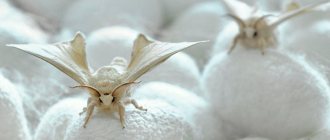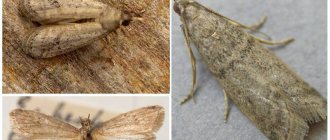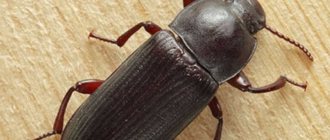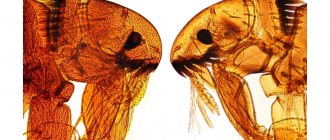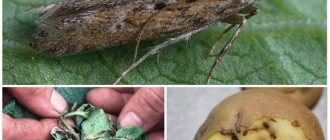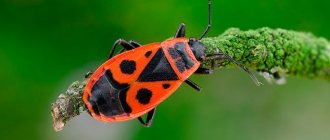Many of us have a summer cottage where we grow berries, herbs and various vegetables with great pleasure, doing everything to get a good harvest. However, despite all efforts, this does not always work out. Sometimes the weather is not pleasant, but most often many plantings are destroyed by all sorts of pests. Take the same cabbage. This plant very often suffers from cabbage moth. More precisely, from its caterpillars, which eat the vegetable, making its further growth and storage impossible, as well as causing spoilage of the fruit. Therefore, we decided to help many amateur gardeners and talk about a variety of methods of combating cabbage moths.
Cabbage moth: description and important information
Before you begin to effectively combat the pest, you need to learn more about it.
The cabbage moth (Latin name Plutella xylostella) is a type of butterfly. It belongs to the sickle-winged moth family (order Lepidoptera), which, by the way, includes dozens of other pests. Scientists call Southern Europe the homeland of this insect. The cabbage moth is widespread throughout Africa, America, Australia, Asia, etc. It even lives in northern latitudes. Moreover, the center of mass appearance of this flying pest is usually located in the warm Mediterranean.
The butterfly has an elongated shape and is distinguished by its discreet color (gray, brown or beige colors predominate). Therefore, cabbage moths can be difficult to detect. It resembles part of a straw or a withered piece of grass. In addition, the size of the insect is relatively small: the wingspan rarely exceeds 1.5 cm, and the body length is only some 5-8 mm.
It doesn't fly well. The average distance is 2 m. However, due to the wind and light weight, the cabbage moth can easily move considerable distances.
The insect appears between April and July. It feeds on plant sap. At the same time, it is more active in the evening, and during the day it prefers to hide from the scorching sun.
What is cabbage moth and how to fight it
The cabbage moth does not eat cabbage; it feeds on the nectar of flowering plants. The pest of cruciferous crops is its larva. Cabbage moth butterflies are heterosexual: females differ from males in the lighter color of their gray-brown or grayish-brown narrow wings.
The appearance of the imago (adult insect) is unremarkable - the wingspan is from 11 to 17 mm, the front wings have a yellow-white wavy stripe on the edge, the hind wings are decorated with a long silver-gray fringe.
Butterflies fly poorly, therefore, after leaving the pupal stage, they do not independently move long distances from the place of birth; they are carried long distances by the wind. The wide distribution of cabbage moths around the world is associated with the movements of eggs, caterpillars and pupae on host plants.
Moth eggs are oval, 0.4-0.5 mm long, slightly flattened, color from pale green to lemon yellow. Young larvae lack pigmentation but have a dark brown head. Caterpillars emerging from eggs penetrate into the pulp of cabbage leaves and after 2-3 days emerge on the surface of the lower part of the leaves.
After the first molt, caterpillars are difficult to see on cabbage leaves due to their green body color. It tapers on both sides, is covered with sparse hairs, and measures from 9 to 12 mm. They are very mobile, run away from touch, and escape by hanging on a thin thread of web.
Caterpillars gnaw out the pulp of cabbage leaves, forming round holes. The caterpillars then penetrate the young heads of cabbage. There they fatten up and return to the leaves to form a cocoon. Inside the cocoon, the caterpillar turns into a pupa.
The emergence of butterflies occurs 6-7 weeks after the first adults lay eggs. The number of generations of cabbage moths depends on the climate of the habitat. In cold regions, such as the Murmansk region, the moth will give one generation, in Ukraine and Belarus 3-4, in Turkmenistan up to 10.
In hot climates, cabbage moths can overwinter in both the pupal and butterfly stages; the development cycle in these conditions is 35-40 days. In the northern regions where cabbage moths live, pupae are able to tolerate very low temperatures and begin to develop at +9°C. Pupae overwinter in mulch and on plant debris.
You never knew this about cabbage. White cabbage composition of vitamins. Beneficial features
Features of reproduction
What else is important to know about cabbage moth? There are several facts that can help in one way or another in the fight against it. They concern the stages of reproduction and life of an insect pest.
- The full development cycle of the cabbage moth is a little over a month. During this time, she manages to turn from an egg into a butterfly, give birth and die.
- Most often it lays eggs on the inside of cabbage leaves. And more than a hundred pieces in my life. The cabbage moth eggs themselves are small in size and elongated in shape. They are approximately 0.4 mm in length and 0.25 mm in width. The color of the eggs is almost always identical to the color of the food plant.
- Already three days after laying, larvae (caterpillars) appear. They live for about 12 days. After which pupae are formed from them. They, like butterflies, are able to survive the winter, withstanding low temperatures. The insect also remains in the pupal stage for 12-14 days.
- The cabbage moth caterpillar usually tries to stay separate from its “comrades.” Most often, 2-3 individuals sit on one sheet. However, it also happens that the entire fruit is covered with larvae.
As you can see, the cabbage moth goes through several stages during its life. When can it cause the most damage to your plantings? Let's find out further.
For reference! At temperatures below 4°C, cabbage moth caterpillars and eggs die.
Favorite plants
From all the abundance of plants in the garden, the cabbage moth tries to lay eggs on representatives of the cruciferous family:
- All types of cabbage;
- Turnips;
- Radish;
- Swede;
- Rape;
- Mustard;
- Horseradish, etc.
The cabbage moth prefers leaves, but does not disdain the ovary and stems. Having emerged from the egg, the larvae bite into the layer of the leaf, making passages there. After the caterpillar grows to a certain size, it climbs to the surface, where it continues its dubious “work.”
What does cabbage moth eat?
How exactly is cabbage moth dangerous?
The butterflies themselves do not harm plants or their fruits. The crop is eaten by their offspring, which hatch from eggs. Having emerged, the caterpillars (larvae) of the cabbage moth begin to diligently feed on leaves, ovaries and buds. As a result, it usually takes them a couple of days to destroy the fetus. As a rule, after prolonged eating by parasites, the head of cabbage begins to rot. As for the caterpillars, they move with great pleasure to another cabbage growing nearby.
After time, the butterfly itself emerges from the eaten larva. It is capable of almost immediately producing new (and more than one) offspring of pests. So, without timely intervention, the gardener risks being left without a harvest of cabbage (lettuce, turnips, radishes, radishes, etc. - this insect also loves them). But there is no need to worry. Moreover, we will present to your attention the most effective measures and means of combating cabbage moths.
Cabbage moth caterpillars are greenish in color. This allows them to camouflage well.
Cabbage moth, control measures using folk remedies
During the absence of pesticides, cabbage moth infestations were not as bad as in the 21st century. Therefore, gardeners fought pests with the help of herbal infusions.
The smells of celandine, tobacco, wormwood, tomato tops, and dandelions could mask the smells of cruciferous plants and prevent cabbage moth butterflies from laying eggs on cabbage or turnips. The treatments were effective because they were carried out in the first days when cabbage moth butterflies began to emerge.
If you sow tobacco seeds around the perimeter of the garden bed, its bushes will protect the cruciferous plants from the attack of butterflies. If the butterflies are able to lay eggs before the tobacco begins to emit an aroma that repels butterflies, then cabbage that is beginning to bush or young heads of cabbage can be treated with a decoction of tobacco leaves.
A decoction is prepared from dry tobacco leaves. They are crushed and dipped in boiling water: 1 glass of tobacco is used for 5 liters of water. The water should boil, after which the fire should be turned off.
After cooling, the liquid should stand for at least 2 hours. The infusion is filtered and the leaves of moth-infested plants and the soil underneath are treated with it. In the same way, decoctions of wormwood, celandine, lavender, tangerine and orange peels are prepared.
Decoctions are used to repel butterflies at the initial stage of egg laying. At the same time, they inspect the plants and remove damaged leaves and egg laying.
Butterflies can be repelled using
- bay leaf - crushed it is scattered on the beds under the plants and in the aisles;
- dandelion - 0.5 kg of fresh leaves are ground in a meat grinder, the juice is squeezed out of the pulp, which is poured into 10 liters of water, an adhesive from 1 tbsp is added to the mixture. liquid soap, let it brew for 3-4 hours, filter and treat the plants at the rate of 1 liter per 1 m² of bed, the treatment is carried out with a sprayer with a long handle so that the composition can get to the lower parts of the leaves;
- fresh tomato tops - crush them (2 kg), pour boiling water (5 l) and bring to a boil, leave on low heat for half an hour, allow time to cool and infuse for at least 2 hours, filter, add an adhesive dissolved in water to the infusion laundry soap (60 g/200g), filter the mixture, mix thoroughly and use for its intended purpose.
To destroy cabbage moth larvae, use insect repellent shampoo for animals: 2 tbsp. stir in 10 liters of water and spray the plants with this mixture. Whey, little by little poured into tall containers and placed between plants (to do this, you can cut plastic bottles and dig them into the ground), will become bait for cabbage moths - butterflies will fly into the bottles, but with wet wings they will not be able to fly back.
How to reliably protect cabbage with folk remedies
And in this video you will learn how to fight not only moths, but also protect seedlings when planting, how to care for them. Moreover, all this is available with affordable means that any housewife has.
How can you tell if there are cabbage moths in your garden?
It is not difficult to determine that this pest has infested your dacha or garden plot. The presence of cabbage moths is indicated by several points:
- The nature of the damage to the plant is gnawed and torn holes in the leaves, eaten ovaries, rotting heads of cabbage.
- Yellowish and dark spots on cabbage.
- Slow growth of culture.
- Dried lower leaves.
- Moves in cut cabbage heads.
- The presence of the caterpillars themselves.
Thus, there are many clear signs of the appearance of a voracious pest. It is important to be careful and regularly inspect your plantings. At the same time, the moth itself (if it is in your garden) can be seen closer to sunset. Usually in the late evening when the sun sets, she flies over the plants, looking for the best places to lay eggs.
Cabbage moths often live on rapeseed, a plant that gardeners love to use as green manure. Therefore, if you decide to start this oilseed crop in your garden, then be prepared for the possible appearance of flying pest butterflies and their caterpillars.
Causes of moths
The appearance of these pests directly depends on climatic conditions, namely temperature and humidity. If the winter is warm and at the same time quite humid, there will be a massive spread of moths.
The fact is that such climatic conditions are favorable for the early development of cruciferous weeds, which means that the first generation of moths will have an ideal food supply. Further, warm weather will contribute to the development of the first generation and the second population will appear in the second half of June.
If the summer is dry and hot, these moths can become the main pests in fields and vegetable gardens. In addition, it was noticed that if one plant is grown in one place for 6 years or more in a row, a sharp increase in the population is observed.
Chemicals
Despite the fact that only the caterpillars themselves cause harm, you also need to fight the butterflies themselves. After all, our main task is to prevent the insect from laying larvae on the cabbage. Special chemicals can help with this. Most often, farmers use:
- Karbofos;
- Decis;
- Aktellik;
- Ambush;
- Ripcord;
- Nurell;
- Sodium silicofluoride;
- Inta-vir, etc.
All insecticides must be used according to the instructions! In this case, you cannot process fruits that are already close to ripening. Spraying with chemicals is allowed only 4 weeks before harvest. As a rule, this time is enough for toxic and harmful substances to evaporate, and the vegetable can be consumed without risk to health.
At the same time, do not forget that chemicals actively destroy adult cabbage moths. But they often have no effect on the larvae. Therefore, it is better to re-treat after 7-10 days.
Description of the appearance of the pest
Cabbage moth is rightfully one of the most common species. Outwardly, a very faded and inconspicuous pest does not stand out as anything special.
The size of an adult cabbage moth with outstretched narrow wings does not exceed 17 mm. It may be less – 12-14 mm. The caterpillar is approximately 9-10 mm long and has 16 legs. The pupa rarely exceeds 8 mm in length. The eggs are small, oblong: 0.2 mm wide, 0.4 mm long.
The color of the cabbage moth is grayish-brown. There are different variations from light yellow to brown. A distinctive feature is a light contrasting wavy stripe running along the entire front wing. The wave forms three bends. The rear solid colored wings often have fringe.
The spindle-like caterpillar is almost colorless at the very beginning, but becomes green over time. The setae are sparse, black, the head is dark. The pupa is yellowish-brown, and the clutch of cabbage moth eggs is green.
Biological agents
Bacteriological (biological) agents are effective against cabbage moths. These are also insecticides. Only they contain bacteria that have a fatal effect on pests and can destroy them in the garden in the shortest possible time. Moreover, such biological products are safe for animals and humans. After all, they do not contain chemically harmful components.
However, when using bacteriological agents against cabbage moths, you should remember that they act only 3-4 days after the start of use. You should not hope for instant results.
Another important point concerns the fact that the pest often gets used to and adapts to a specific type of drug. Therefore, it is not recommended to constantly use the same product. Its effectiveness is significantly reduced. This means that if one biological insecticide does not work, then feel free to use another. Or even switch to chemicals if you can’t get rid of cabbage moths and their caterpillars.
At the same time, you can also collect parasites manually. On average, it is possible to collect about 30% of insects from one plant. Thus, most of it usually remains invisible to the gardener. Therefore, we would not recommend limiting ourselves to only physical methods of combating cabbage moths.
Microbiological insecticides
The fight against cabbage moths is carried out using special microbiological insecticides. These products are based on bacterial spores and their toxins. As soon as the caterpillar eats a cabbage leaf treated with an insecticide, paralysis of the insect occurs with further death. Such drugs can be called effective if the ambient temperature rises above 16 degrees, when the feeding activity of insects increases. The use of bacterial agents does not cause the death of insects immediately, but after 3-5 days.
Microbiological agents are non-toxic to humans and animals, so there are no restrictions on their use. The main bacterial preparations include the following:
- Lepidocyte;
- Gomelin;
- Entobacterin;
- Bactospein;
- Dendrobacillin.
A drug such as Lepidocid contains pathogenic bacteria that have the ability to kill insects in 2 days. After spraying crops with this drug, the protective effect lasts for 14 days, which increases the yield level. Reviews about Lepidocide are positive, which is due not only to its effectiveness, but also to its ease of use. The cabbage moth also develops immunity to microbiological preparations, so it is recommended to alternate such agents.
Tips to help you fight cabbage moths:
Folk methods of struggle
The fight against cabbage moths with folk remedies is popular. There are quite a lot of them. Let's look at the most popular and interesting ones:
- Often, summer residents plant tobacco, enclosing beds and rows of cabbage with it. Its smell is believed to repel these pests.
- Some amateur gardeners sprinkle the stems and leaves of plants on which cabbage moth caterpillars may appear with crushed bay leaves.
- As a means of combating this pest, they also use regular dog flea shampoo, which is first diluted in water and then sprayed on the plantings.
- Various other solutions are also used against cabbage moths. For example, from wood ash (10 liters of water + a couple of glasses of ash + a glass of dissolved laundry soap), which is sprayed on the leaves of the plant. A solution of mustard, black and red pepper is popular in the fight against this pest. It is prepared in the following proportions: a little water, 2 tbsp. l. mustard and salt, as well as 1 tsp. each type of pepper.
- Some summer residents and gardeners keep lizards or frogs in their plots, which are considered natural enemies of the cabbage moth and eat it. This method of fighting is quite exotic. After all, you still need to somehow prevent the lizard or frog from leaving the garden.
- Another popular method is to place bird feeders on the site and make birdhouses. Flying animals happily eat cabbage moths. However, many of them do not touch the caterpillars. Basically, birds prefer to peck the butterflies themselves.
Cabbage moth: how to get rid of the pest?
You can get rid of cabbage moths using different methods, which will be discussed below.
Physical methods of controlling cabbage moths
This method will be effective only at the beginning of an area being infested with pests, when the number of insects is still small.
There are the following physical ways to combat cabbage moths:
- manual collection of parasites. This method is quite tedious and unpleasant. As a rule, it is possible to collect about 1/3 of the pests manually, since the rest are well hidden or located in hard-to-reach places;
- thorough cleaning and weeding of plantings also helps reduce the pest population;
- Annual digging of the earth helps to destroy cabbage moth pupae, and, consequently, reduce the number of moths for the next year.
Another way to combat cabbage moths is traps. Moth traps themselves are not particularly effective, but they make it possible to determine the degree of infestation of an area and help reduce the number of pests. Traps are perfect as an additional measure to combat cabbage moths.
Butterflies fly in the evening and at night, but they flock to the light. A simple way to make a trap is to pour vegetable oil into a saucer and place it at a distance of 10-15 cm under a lamp. The cabbage moth will react to the light, fly towards it, fall into the oil, and it will no longer be able to get out of there. The trap must be placed between the beds.
Chemicals against cabbage moths
Chemical insecticides are perhaps the most popular method of controlling cabbage moths.
To combat the pest, it is not enough to treat several beds of cabbage, since in this case there is a high probability of re-infestation. For this reason, it is necessary to carry out a comprehensive insect control.
The following drugs will be effective against cabbage moths:
- Aktellik;
- Sodium silicofluoride;
- Ambush;
- Ripcord;
- Karbofos;
- Nurell.
Insecticides are toxic drugs, so when using them you must follow safety precautions:
- use protective equipment (respirator, gloves);
- Carry out the treatment before the start of cruciferous flowering (the exact timing is indicated in the instructions for the product).
It is best to use drugs in dry weather, as rain will reduce their effectiveness.
The disadvantage of using insecticides is that they only affect caterpillars and butterflies, leaving the adult larvae and pupae to survive. To destroy them, it is necessary to re-process.
Pests may develop an addiction to a certain drug; to avoid this, you need to periodically change insecticides.
Biological preparations against cabbage moth
Biological preparations are based on bacterial spores and their toxins. The advantage of this composition is that, unlike chemicals, biological agents are non-toxic and safe for humans and animals.
When a caterpillar eats a cabbage leaf treated with a microbiological insecticide, it becomes paralyzed and the larva dies.
The drugs will be effective only if the air temperature is above 16°C, because in warm weather the caterpillars are more voracious, so there is a higher chance that they will eat the poison.
The following drugs will help in the fight against cabbage moth:
- Entobacterin;
- Lepidocide;
- Bactospein;
- Dipel;
- Bitoxibacillin;
- Dendrobacillin;
- Gomelin.
As with chemicals, cabbage moths can develop immunity to biological agents, so you need to alternate agents.
Traditional methods of fighting cabbage moths
If you do not want to treat plants with biological and especially chemical preparations, then homemade decoctions will be a good alternative. They will cost less and will also be safe. The only drawback is that you have to spend time preparing the decoction.
Below are recipes for infusions against cabbage moths:
- Tobacco decoction. Mix 2 cups of tobacco leaves and pour 10 liters of boiling water over them. Allow time to cool, strain.
- Decoction of tomato tops. Mix 5 liters of water with 2 kg of tomato tops, bring to a boil and simmer over low heat for half an hour. Let cool, strain. Before use, add 60 g of crushed laundry soap. Dilute the resulting infusion with water in a ratio of 1:3.
- Orange infusion. Mix orange peel, dried lavender flowers and laundry soap.
- Wood ash solution. Mix 2 cups of wood ash with 10 liters of water and 60 g of laundry soap.
- Dandelion decoction. Add 500 g of crushed dandelions and a tablespoon of liquid soap to 10 liters of water. Leave for at least 3 hours.
- Spice decoction. Dissolve 2 tablespoons of mustard and table salt in water, as well as a teaspoon of red and black pepper.
The cabbage moth has its own natural enemies: lizards, frogs and birds. They help reduce the number of insects.
Insects like to feed on cabbage moth larvae include Trichogramma, Nitobia, and Apantelesa. Attracting beneficial insects is simple - just plant plants that attract them next to cruciferous crops: parsley, onions, mustard, cilantro, carrots, dill, clover, etc.
Prevention of occurrence
Getting rid of cabbage moth caterpillars can be difficult. Therefore, the best way to combat such pests is prevention. Even if it does not provide 100% protection, it will at least reduce the number of voracious garden insects. So we recommend that you carry out the following activities:
- Before winter, dig deep into the soil.
- Do not forget about careful plowing and destruction of crop residues, green manure plants, etc. They are the favorite wintering place for cabbage butterfly pupae.
- Constantly monitor the number of weeds. And also close to the site. Abundant grass growing around the perimeter of the garden is a breeding ground for these pests.
- Follow crop rotation. Avoid planting cruciferous vegetables in the same place every year.
- Check cabbage leaves regularly for cabbage moth eggs and caterpillars.
Prevention
Considering that pest control in agriculture is systematic, the developed preventive measures are effective and efficient. These include:
- Maintaining crop rotation. You cannot plant cruciferous vegetables in the same place year after year.
- High agriculture. First of all, the destruction of weeds: it is on them that the cabbage moth makes its first clutch.
- Autumn plowing or digging up an area: pupae or adult cabbage moths overwinter in the ground. Therefore, turning out clods before frost is an excellent measure to combat the pest.
- Destruction of plant residues after harvesting. When leaving cabbage leaves or stalks on the plot, you should always remember that they may contain pupae or eggs. They belong in compost, not in the garden.
The chemical industry and folk experience provide a wide range of moth control measures, but they are not always effective. The cabbage moth develops immunity quite quickly, so after treatment it is necessary to monitor its behavior: if the drug works, then repeat it after two weeks. If not, then you need to immediately look for a replacement and not wait until the moth destroys the entire crop.
Sources
- https://domvred.ru/kapustnaya-mol/
- https://sovusadba.ru/vrediteli-i-bolezni/kak-izbavitsya-ot-kapustnoy-moli-opasnogo-vreditelya-krestotsvetnyh.html
- https://vredinfo.ru/mol/kapustnaya-mery-borby
- https://parazitdoma.ru/mol/kapustnaya
- https://GdeKlop.ru/mol/kapustnaya-mol/
- https://urozhajnayagryadka.ru/kapustnaya-mol-kak-s-nej-borotsya-narodnye-sredstva-i-insekticidy/
- https://KlopSOS.ru/mol/metody-borby-s-kapustnoj-molyu/
- https://glav-dacha.ru/kapustnaya-mol/
- https://sad6sotok.ru/%D0%BA%D0%B0%D0%BF%D1%83%D1%81%D1%82%D0%BD%D0%B0%D1%8F-%D0%BC% D0%BE%D0%BB%D1%8C.html
[collapse]
Fight to destruction
If the defeat has become widespread, then it’s time to use more powerful drugs against cabbage moths.
Attention! Massive damage to plants is called when there are more than five caterpillars on one of them, or the damage affected 10-15 percent of the total planting area.
Insecticides against cabbage moths are used both chemical and bacterial.
Chemical
Chemical preparations are best used at the beginning of butterfly summer, as they work best on adults and young larvae, while adult caterpillars and pupae are resistant to chemicals.
Recommended chemicals, dosage shown in grams per ten liter bucket of water:
- karbofos - 60;
- sodium fluoride – 100;
- actellik – 100;
- Ambush – 80;
- ripcord – 20;
- talkcord - 80;
- Nurrell – 30.
Bacterial
Bacterial preparations are classified as internal agents. They are less dangerous for humans and domestic animals, as they act on the gastrointestinal tract of caterpillars.
Recommended bacterial preparations and their concentrations:
- entobacterin - 5;
- bactospein -3;
- gomelin – 1.5;
- bitoxybacillin -1.5;
- dendrobacillin -1.5;
- dipel - 2;
- lepidocide – 1.5.
Folk
Among folk remedies, we can recommend a tincture of dandelions with liquid soap for better adhesion. The dosage of the drug is as follows:
- dandelion leaves – 500 grams;
- liquid soap – 20 grams;
- water – 10 liters.
You need to infuse this solution for three hours, then strain and spray at the rate of spending one liter of infusion per square meter of sown area.
Advice! When treating with any of the insecticides, spray the underside of the leaves especially carefully, as this is most infested with cabbage moth caterpillars.
It would be hard to look at it, but to complete the picture we’ll still add a video
about cabbage moth.
Lifestyle and reproduction
The food preferences of the cabbage moth include not only all types of cabbage, but also other cruciferous vegetables: rapeseed, turnips, turnips, radishes, radishes, mustard, crispy lettuce leaves. A minimum temperature of 4°C is required for development. Moreover, the higher the temperature, the less chance vegetables have.
In different areas, depending on weather conditions, up to 6 generations of pests develop. A female cabbage moth lays an average of 70-170 eggs, and the clutch is not massive - several eggs per plant. After 2-3 days, the larvae appear and begin to colonize the leaves. In 1.5-2 weeks they are able to gnaw their way to the growth point and thereby leave you without a harvest. Under the protection of numerous leaves, the pest pupates and, after a couple of weeks, an adult cabbage moth emerges, ready for further reproduction.
The life cycle under favorable conditions is 15-33 days.
The larvae of cabbage moths cause the greatest harm: storing up energy for further growth, they can completely destroy the crop.
Pupae and adult moths overwinter in the ground or on weeds, stumps, and cabbage leaves left after the harvest.

